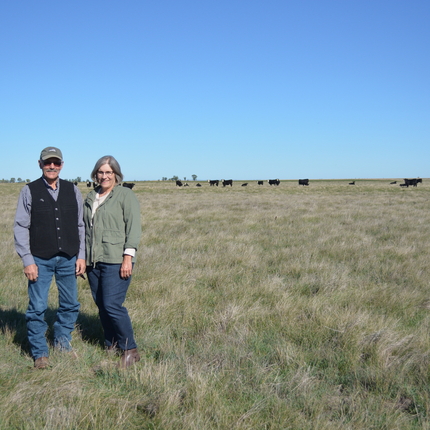This story was published in the Tri-State Neighbor on Nov. 19
Farmers and ranchers interested in implementing conservation on their operations can receive valuable technical and financial support through the Conservation Stewardship Program (CSP) and Environmental Quality Incentives Program (EQIP). In South Dakota, the deadline to submit initial paperwork for these programs is Dec. 3.
Administered by the U.S. Department of Agriculture’s Natural Resources Conservation Service (NRCS), these working lands conservation programs provide a framework for producers to address natural resource concerns while maintaining agricultural production.
Mel and Jan Gimbel, who own Wolf Creek Ranch LLC near Ree Heights, South Dakota, have been enrolled in CSP for four years. Organic since 2008, the couple couldn’t resist the opportunity to take part in a program that incentivized their conservation goals and desire to grow healthy food. In fact, many of the practices they were implementing to maintain their organic certification are included in their current CSP plan.
“Field borders are required in organic production to cut back on drift, while our CSP contract recommends them to reduce water erosion,” Jan said, noting that one conservation practice can have multiple, positive effects.
With support from their children Johannes and Lexy, the Gimbels also plant an extended crop rotation, seed cover crops, and practice rotational grazing as keystones of their CSP contract. Their operation includes 1,000 acres of farmland, fostering a rotation of row crops, small grains, and alfalfa, and 1,500 acres of pasture for 175 cow-calf pairs and a set of replacement heifers.
Like field borders, cover crops have proven beneficial in more ways than one. In addition to their capacity to increase nutrients and hold soil in place, the Gimbels find cover crops to be prime grazing fodder. Compared to perennial grasses, cover crops are more likely to bounce back following light rain showers—for the Gimbels this meant feed for their cattle when pastures lagged due to drought. The key, according to Mel, is to plant as diverse a mix as possible.
“The more the merrier,” he said, noting they have planted as many as nine species into a single field.
CSP contracts like the Gimbel’s are designed to strengthen existing conservation efforts operation-wide and require applicants to demonstrate they are currently addressing regional resource concerns. They must also be willing to implement additional practices—called enhancements—that build upon these existing efforts.
In contrast to the holistic nature of CSP, EQIP allows producers to address a particular resource concern, such as erosion or water quality, with a single practice or project. No prior conservation experience is required, making EQIP an ideal option for beginning farmers and ranchers.
The Gimbels remember the days when concepts like soil health were new to their vocabulary and encourage producers getting a start in conservation to reach out for help. Even today, Mel and Jan seek advice from their community, including local grazing and soil coalitions and their NRCS field agent, and attend field days regularly. In fact, their state Ducks Unlimited chapter helped the Gimbels apply for an EQIP contract to install permanent perimeter fencing, water pipelines, and water tanks for grazing their cover crops and crop residue.
Being connected to community, however, isn’t the only relationship that’s meaningful to the Gimbels. Their relationship to the land is equally important, as it is for many of the farmers and ranchers in South Dakota who enrolled nearly 500,000 acres in working lands programs last year.
“You want to be a part of nature, not apart from it,” Mel said, adding that when you give to the land it’s better able to return the favor.
Farmers and ranchers interested in applying for CSP or EQIP should contact their local NRCS office as soon as possible to set up an appointment. A list of local offices can be found at offices.sc.egov.usda.gov. Both conventional and organic operations are encouraged to apply.
To prepare producers for their visit with USDA, the Center for Rural Affairs has released a series of fact sheets that answer frequently asked questions about these programs. The resources can be found here under the title, “What To Know About Implementing Conservation Practices.”
Feature photo: Mel and Jan Gimbel stand on their Ree Heights, South Dakota ranch. | Photo submitted





